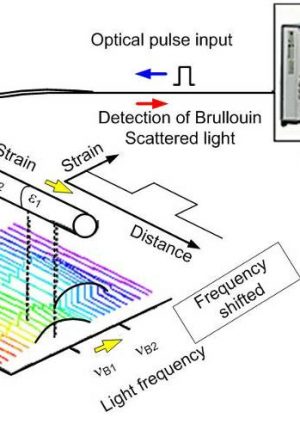The Role of an Optical Fibre Diameter Analyser in Quality Control
The Role of an Optical Fibre Diameter Analyser in Quality Control
Blog Article
Enhance Your Fibre Optic Projects With a Reliable Diameter Analyser
The combination of a reliable size analyser right into fibre optic jobs works as a crucial element in accomplishing accuracy and consistency. By promoting accurate diameter measurements, these analysers not only boost the quality of installments but likewise alleviate possible compatibility concerns amongst components. Additionally, the sophisticated abilities of modern-day analysers simplify information collection and quality control processes. As we explore the critical attributes and advantages of these tools, it becomes apparent just how they can change job results and guarantee adherence to industry criteria. What continues to be to be gone over is how to effectively execute these analysers in your existing workflows.
Value of Diameter Dimension
Determining the diameter of fibre optic wires is an important job that makes certain optimum performance and reliability in interaction systems. Accurate diameter measurement is essential for different reasons, mainly for preserving signal stability and lessening loss. A cable television's size straight affects its ability to transmit light effectively; discrepancies from the specified diameter can result in enhanced attenuation, which affects the overall performance of the network.
Furthermore, accurate dimension is crucial during the installment and upkeep of fiber optic systems. An incorrect fit between cable televisions and connectors can result in signal destruction or full failing of communication links. By making sure that sizes are within specified resistances, specialists can enhance compatibility in between parts, bring about enhanced system dependability.
Additionally, size dimension plays a considerable role in quality control throughout manufacturing. Consistency in the size of fiber optic cable televisions is essential for making certain consistent efficiency throughout different batches. optical fibre diameter analyser. This uniformity assists manufacturers keep sector standards and fosters self-confidence among end-users
Attributes of an Effective Analyser
An efficient analyser for fiber optic projects have to integrate several vital functions that enhance precision and usability in diameter dimension. High-resolution optical sensing units are important for exact diameter analyses, enabling individuals to spot also the smallest variations in fibre density. These sensors need to be complemented by sophisticated calibration systems, making certain constant efficiency throughout different problems and materials.
Secondly, a straightforward interface is important for promoting simplicity of operation. This includes user-friendly software program that allows for smooth data input and outcome, together with visual depictions of the dimensions taken. A portable design improves functionality in different area settings, making it easier to carry out analyses on-site.
In addition, the analyser needs to support numerous dimension modes, accommodating various fibre types and applications. The ability to store and retrieve historic information is one more vital function, allowing individuals to track efficiency over time and make notified decisions.
Benefits for Fibre Optic Projects
Executing a diameter analyser in fibre optic projects provides substantial benefits that significantly enhance task performance and top quality. One of the main advantages is the ability to ensure exact measurements of fiber size, which is crucial for maintaining optimum efficiency in fibre optic systems. Accurate look here size analyses aid in the recognition of incongruities that might result in signal destruction or loss, hence making certain top quality transmission.
In addition, making use of a diameter analyser streamlines the top quality control procedure. By automating measurement jobs, job groups can minimize the moment invested on manual examinations, bring about faster job completion and lowered labour expenses. This efficiency additionally enables more extensive testing protocols, leading to enhanced product reliability.
Furthermore, uniformity in fibre diameter measurements advertises compatibility with other fiber optic elements, minimizing the danger of setup mistakes and improving total system efficiency. The incorporation of a diameter analyser not just aids in preserving industry standards yet also promotes self-confidence in project deliverables.
Assimilation Into Existing Workflows
Integrating a size analyser into existing process can considerably boost the operational effectiveness of fibre optic projects. By flawlessly incorporating why not try this out this innovation, teams can attain specific measurements that are vital to preserving the integrity and performance of fiber optic systems. This assimilation allows for real-time information collection and evaluation, which can be vital throughout the production and setup stages.
In addition, the ability to automate diameter measurement procedures reduces the potential for human error, making sure constant top quality control throughout the task lifecycle. The information generated can be quickly shared across platforms, helping with partnership amongst engineers, professionals, and project supervisors. This availability improves decision-making and speeds up job timelines.

Selecting the Right Size Analyser
When choosing a diameter analyser for fiber optic jobs, it is important to think about several vital elements that straight effect dimension accuracy and operational effectiveness. Initially, the resolution and precision of the analyser must line up with the specific needs of your task. Greater resolution tools can detect minute variations in size, which is important for ensuring ideal efficiency in fibre optic systems.
For projects with tight due dates, a size analyser that supplies rapid information procurement can considerably improve efficiency. Additionally, think about the analyser's compatibility with existing systems and software application.
One more important aspect is the variety of diameters the analyser can suit. By very carefully evaluating these factors, you can pick a diameter analyser that boosts the effectiveness and accuracy of your fibre optic projects.
Verdict
In verdict, the integration of a reliable diameter analyser is paramount for boosting fibre optic tasks. Exact diameter dimensions ensure optimum performance and reliability while lessening installment mistakes. Advanced functions assist in real-time data collection and compliance with industry criteria, inevitably elevating the top quality of deliverables. By prioritizing the choice and implementation of an ideal analyser, project performance is considerably improved, paving the means for successful end results in fibre optic applications.
A cable television's diameter directly influences its capability to send light efficiently; discrepancies from the defined size can lead to raised attenuation, which affects the total efficiency of the network.

Report this page